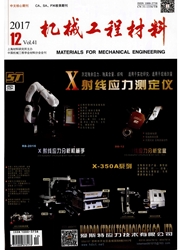

 中文摘要:
中文摘要:
利用扫描电子显微镜获取了Ti-6Al-4V双相钛合金的显微组织,然后结合图像处理、几何建模等技术建立了基于显微组织的代表性体积单元(RVE)有限元模型;利用ABAQUS有限元软件对RVE进行了拉伸时的微观应力和应变有限元模拟,并采用单轴拉伸试验进行了验证。结果表明:RVE的应力-应变曲线与试验结果吻合得很好,说明所建立的RVE有限元模型是准确的;在外加载荷作用下,微观应力和应变的分布不均匀,最大应力存在于β相中,最大塑性应变则出现在α相中,在α/β相界面区域发生应力和塑性应变的较大波动;应变局部化主要在靠近α/β相界面的α相内出现,随之形成的塑性应变失效带在α相中扩展。
 英文摘要:
英文摘要:
The microstructure of a two-phase Ti-6Ab4V alloy was obtained by scanning electron microscope, and then the finite element model of representative volume element (RVE) was established based on the microstructure by the combination of image processing and geometric modeling methods. The micro stresses and strains of RVE were simulated by the finite element software of ABAQUS and verified by the uniaxial tension test. The results show that the simulated stress-strain curve of RVE was in good agreement with the measured result, indicating the accuracy of the established RVE finite element model. Under the outer loads, the distributions of micro stresses and strains were inhomogeneous. The maximum stress existed in β phase while the maximum plastic strain occurred in α phase, and a relatively high fluctuation of the stresses and plastic strains occured near α/β interface. Plastic strain localization mainly occurred in α phase close to α/β3 interface and the following plastic strain failure band extended in α phase.
 同期刊论文项目
同期刊论文项目
 同项目期刊论文
同项目期刊论文
 Crack initiation life prediction of materials due to the combination of pitting corrosion and fatigu
Crack initiation life prediction of materials due to the combination of pitting corrosion and fatigu Microstructure and wear resistance of one-step in-situ synthesized TiN/Al composite coatings on Ti6A
Microstructure and wear resistance of one-step in-situ synthesized TiN/Al composite coatings on Ti6A Grain size effect on the small fatigue crack initiation and growth mechanisms of nickel-based supera
Grain size effect on the small fatigue crack initiation and growth mechanisms of nickel-based supera Effect of laser power on the microstructure and mechanical properties of TiN/Ti 3 Al composite coati
Effect of laser power on the microstructure and mechanical properties of TiN/Ti 3 Al composite coati Tensile properties and fracture behavior of laser cladded WC/Ni composite coatings with different co
Tensile properties and fracture behavior of laser cladded WC/Ni composite coatings with different co Effects of processing conditions on the mechanical properties and deformation behaviors of plasma-sp
Effects of processing conditions on the mechanical properties and deformation behaviors of plasma-sp Effects of creep-aging processing on the corrosion resistance and mechanical properties of an Al-Cu-
Effects of creep-aging processing on the corrosion resistance and mechanical properties of an Al-Cu- Fabrication and characterization of a metal-packaged regenerated fiber Bragg grating strain sensor f
Fabrication and characterization of a metal-packaged regenerated fiber Bragg grating strain sensor f Fabrication and thermal characteristics of multilayer metal-coated regenerated grating sensors for h
Fabrication and thermal characteristics of multilayer metal-coated regenerated grating sensors for h A multiaxial creep-damage model for creep crack growth considering cavity growth and microcrack inte
A multiaxial creep-damage model for creep crack growth considering cavity growth and microcrack inte 期刊信息
期刊信息
